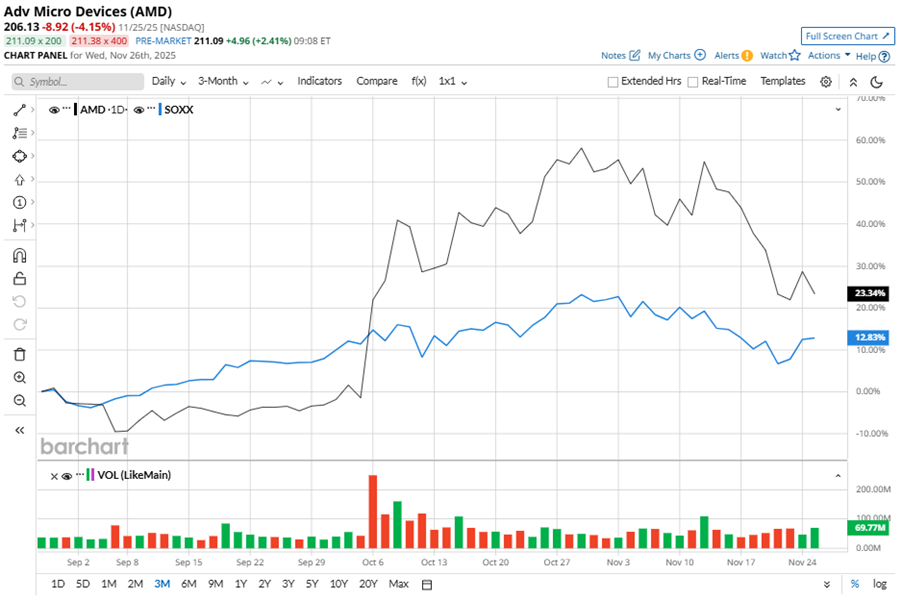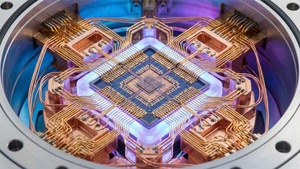Santa Clara, California-based Advanced Micro Devices, Inc. (AMD) produces semiconductor products and devices. Valued at $335.6 billion by market cap, the company offers products such as microprocessors, embedded microprocessors, chipsets, graphics, video and multimedia products and supplies them to third-party foundries, as well as provides assembling, testing, and packaging services.
Companies worth $200 billion or more are generally described as “mega-cap stocks,” and AMD definitely fits that description, with its market cap exceeding this threshold, reflecting its substantial size, influence, and dominance in the semiconductors industry.AMD's strong brand and unique technology give it a competitive edge in the semiconductor market. Their products, including CPUs, GPUs, and APUs, are recognized for their performance and quality. With a diverse product portfolio that spans multiple markets, AMD is well-positioned for growth.
Despite its notable strength, AMD slipped 22.8% from its 52-week high of $267.08, achieved on Oct. 29. Over the past three months, AMD stock gained 23.6%, outperforming the iShares Semiconductor ETF’s (SOXX) 14.1% gains during the same time frame.

In the longer term, shares of AMD rose 70.5% on a YTD basis and 49.5% over the past 52 weeks, significantly outperforming SOXX’s gains of 32.9% each on a YTD basis and over the last year.
To confirm the bullish trend, AMD has been trading above its 200-day moving average since mid-June. However, despite the positive price momentum, the stock has been trading below its 50-day moving average recently.

AMD's strong performance is driven by its growing traction in data center AI chips and rising earnings expectations. The company's Client and Gaming division surged to $4 billion, led by Ryzen processors. The company has secured multi-billion dollar deals with OpenAI and others, and its core businesses like Epyc CPUs are also thriving. Additionally, Oracle Corporation (ORCL) will use AMD's Instinct MI450 GPUs for its AI cloud services which will drive further growth.
On Nov. 4, AMD shares closed down by 3.7% after reporting its Q3 results. Its adjusted EPS of $1.20 beat Wall Street expectations of $1.17. The company’s revenue was $9.3 billion, beating Wall Street's $8.7 billion forecast. For Q4, AMD expects revenue in the range of $9.3 billion to $9.9 billion.
In the competitive arena of semiconductors, NVIDIA Corporation (NVDA) has lagged behind AMD, showing resilience with a 35.1% uptick on a YTD basis and a 32.5% gain over the past 52 weeks.
Wall Street analysts are moderately bullish on AMD’s prospects. The stock has a consensus “Moderate Buy” rating from the 43 analysts covering it, and the mean price target of $291.29 suggests an ambitious potential upside of 41.3% from current price levels.
On the date of publication, Neha Panjwani did not have (either directly or indirectly) positions in any of the securities mentioned in this article. All information and data in this article is solely for informational purposes. For more information please view the Barchart Disclosure Policy here.
More news from Barchart
- ‘These Chips Will Profoundly Change the World’ and ‘Save Lives.’ Elon Musk Doubles Down on AI Chips as TSLA Stock Stagnates YTD.
- This Undiscovered Biotech Stock Has Quintupled in a Year and Just Hit New Highs
- Oppenheimer Thinks Investors Are Missing Out on IBM Stock
- Wedbush Just Raised Its Fannie Mae Price Target 1,050%. Should You Buy FNMA Stock Here?







